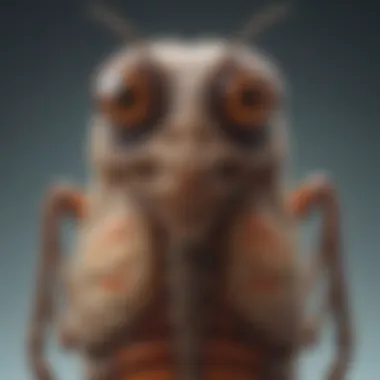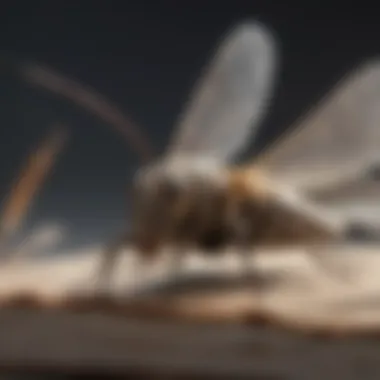Unveiling the Enigmatic World of Booklice: An In-Depth Guide


Preventive Pest Control Strategies
To safeguard your living space from the intrusion of tiny pests like booklice, establishing robust preventive pest control strategies is imperative. Commence this endeavor by fortifying the perimeter of your home. Start by meticulously sealing all cracks and crevices in the walls and foundations, as these minute openings serve as gateways for pests. Furthermore, ensure to clear any debris or clutter, both indoors and outdoors, as these can harbor pests and provide them with ideal breeding grounds. Taking proactive measures to prevent pests from entering your home is vital; install mesh screens on windows and doors, plug gaps around pipes, and address any structural vulnerabilities promptly. Amidst these external efforts, prioritize yard maintenance to create a pest-free outdoor environment. Regularly attend to essential yard care routines such as mowing the lawn, pruning bushes, and removing standing water. These practices discourage pests from congregating near your home, reducing the likelihood of an infestation. When focusing on indoor cleanliness, adopt expert cleaning tips and techniques that target areas prone to pest activity. Regular vacuuming, dusting, and decluttering not only enhance the aesthetics of your living space but also deter pests from taking up residence. By maintaining a pest-resistant indoor environment through meticulous cleanliness practices, you fortify your defenses against booklice and other unwanted intruders. Proper garbage disposal is another critical aspect of effective pest prevention. Implement efficient waste disposal methods, such as sealing trash bags tightly, emptying bins regularly, and disposing of food scraps in sealed containers. Recognize the importance of proper garbage disposal in minimizing attractants for pests, thus mitigating the risk of infestations. In addition to these fundamental measures, explore innovative ways to safeguard your home against potential pest incursions. By combining traditional preventative strategies with modern approaches, you can create a formidable defense system that protects your living spaces from the menace of booklice and other pests.
Identifying Pest Risk Areas
A keen eye for identifying pest risk areas within and around your home is pivotal in proactively managing pest infestations. Begin by conducting thorough inspections of moisture-prone areas, such as basements, attics, and crawl spaces. Identify damp conditions that can foster pest proliferation, such as water leaks or condensation, and promptly address these issues to prevent infestations. Simultaneously, prioritize inspecting cracks and crevices in walls, flooring, and foundations to pinpoint potential access points for pests. Seal these openings with appropriate sealants or materials to impede pest entry and reduce the likelihood of an infestation. Enlist a comprehensive crack and crevice inspection guide to ensure no potential entry point goes unnoticed, reinforcing your pest defense mechanisms effectively. In your quest to mitigate pest risks, extend your inspections to outdoor greenery surrounding your home. Understand the impact of vegetation on pest activity and implement guidelines to maintain a yard that is uninviting to pests. Trimming bushes, clearing debris, and enhancing natural barriers can significantly reduce the attractiveness of your yard to pests, thereby minimizing the risk of infestations. Additionally, be vigilant about other pest risk areas that may escape initial scrutiny. From utility rooms and storage areas to neglected corners, miscellaneous pest risk areas pose hidden vulnerabilities. By identifying and addressing these overlooked spots through targeted preventive measures, you fortify your home against potential pest invasions.
Effective Pest Control Methods
When preventive measures fall short and pest incursions occur, implementing effective pest control methods becomes paramount. Consider integrating natural repellents into your pest control arsenal, offering safe and environmentally friendly solutions to manage pest activity. Utilizing essential oils, herbs, and plants known for their pest-repelling properties can help deter pests without compromising indoor air quality or human health. Explore the safe usage of chemical sprays as another line of defense against persistent pests, while exercising caution to follow product instructions meticulously. These professional sprays can be instrumental in eradicating pests and interrupting their life cycles, leading to more lasting control outcomes. Supplement your pest control tactics with pest traps, which offer targeted solutions for capturing and removing pests safely and efficiently. Learn the optimal placement and usage of traps to maximize their efficacy while minimizing potential risks to non-target organisms. Embrace biological control methods as a sustainable approach to pest prevention, harnessing the power of natural predators to sustainably manage pest populations. By introducing beneficial organisms that prey on pests, you establish a balance in your home environment that controls pest numbers organically. Delve into other innovative pest control methods beyond traditional options to diversify your pest management strategies and tailor solutions to specific pest challenges. Adapting a multifaceted approach to pest control equips you with a versatile toolkit to combat diverse pest threats effectively.
Pest Species Identification
Identifying common pests and understanding their impact on your living environment is essential in devising targeted pest control strategies. When it comes to home pest control, familiarize yourself with common insects that may infiltrate your living spaces, including ants, cockroaches, and spiders. Recognizing the signs of an insect infestation and responding promptly can mitigate potential damage and health risks associated with these pests. In the realm of rodents, knowing how to identify and prevent rodent invasions is crucial for safeguarding your home. Differentiate between mice and rats, recognizing their characteristic behaviors and preferred habitats to enact tailored rodent control measures effectively. Address the impact of birds on home environments as well, acknowledging troublesome bird species that may pose challenges around residential areas. Implement measures to deter unwanted avian visitors from nesting or residing in proximity to your home, preserving the integrity of your living space. When it comes to dealing with wildlife encounters on your property, familiarize yourself with the behavior and control measures suited for diverse wildlife species. From raccoons to squirrels, understanding effective wildlife management techniques is vital in maintaining a harmonious coexistence with wildlife while safeguarding your property. Don't overlook lesser-known pest species that may also pose threats to your home environment. By expanding your knowledge of diverse pests and their behaviors, you empower yourself to address potential infestations proactively.
DIY Pest Control Techniques
Incorporating do-it-yourself (DIY) pest control techniques into your pest management strategy offers a cost-effective and customizable approach to combating pest issues. Discover an array of homemade pest control solutions that leverage common household items to repel pests naturally. From vinegar sprays to citrus peel barriers, these eco-friendly remedies provide effective alternatives to chemical interventions. Harness the repellent properties of essential oils for pest control, creating fragrant barriers that deter pests without harsh chemicals. By combining specific essential oils known for pest-repelling qualities, you can create a bug-free environment in your home while enjoying pleasant aromas. Embrace the efficacy of pest traps and barriers as practical solutions for pest control, deploying these physical deterrents strategically to intercept and prevent pest intrusions. Whether using sticky traps or physical barriers, these tools offer targeted protection against specific pests, aiding in pest management efforts. Explore reputable pest control brands that offer products designed for home use and trusted for their efficacy in pest management. Selecting reliable pest control solutions from reputable brands ensures that you safeguard your home with proven and quality-tested products, enhancing the efficacy of your pest control regimen. Conclude by investigating miscellaneous DIY pest control techniques tailored to a range of pest issues commonly encountered in home environments. By diversifying your approach to pest control and incorporating DIY solutions into your arsenal, you empower yourself to address pest challenges comprehensively and proactively within your living spaces.
Introduction
In the realm of household pests, booklice stand out as intriguing microscopic insects that often find their way into homes and libraries. Despite their tiny size, these creatures can create significant issues if left unchecked, making it essential for homeowners to understand their characteristics, behavior, habitats, prevention methods, and removal strategies. By gaining knowledge about these pests, individuals can effectively combat infestations and safeguard their living spaces and valuable book collections.
Overview of Booklice
Definition and Classification
Diving into the specific aspect of definition and classification of booklice sheds light on the fundamental understanding needed to address these pests effectively. Recognizing the key characteristic of these insects, along with their classification within the realm of household nuisances, provides valuable insights into identifying and differentiating booklice from other similar pests. Understanding where booklice fit in the ecological framework is crucial for devising targeted strategies to control their populations in homes and libraries.


Physical Characteristics
Exploring the physical characteristics of booklice illuminates key traits that set them apart from other insects. Their microscopic size, translucent bodies, and distinct features such as soft bodies and chewing mouthparts contribute to their unique identity. Recognizing these physical distinctions is essential in formulating customized control measures tailored to combat the specific vulnerabilities of booklice, ensuring more effective eradication and prevention strategies.
Significance in Pest Control
Damage to Books
The impact of booklice on literary collections cannot be underestimated, as these pests are notorious for causing extensive damage to books through their feeding habits. The key characteristic lies in their attraction to mold and fungi found in paper products, resulting in irreparable harm to valuable volumes over time. Understanding the relationship between booklice and book degradation is crucial for implementing preventive measures that safeguard cherished books from infestation and deterioration.
Allergies and Health Risks
Beyond physical damage, booklice also pose potential health risks to individuals through allergies and respiratory issues. The presence of booklice allergens in indoor environments can trigger allergic reactions in susceptible individuals, leading to symptoms like sneezing, itching, and respiratory distress. Recognizing the correlation between booklice infestations and health risks empowers homeowners to take proactive measures to mitigate allergic reactions and ensure a healthy living environment for all occupants.
Habitat and Behavior
In the realm of booklice, understanding their habitat and behavior is crucial. The intricate interplay between these tiny insects and their surroundings significantly impacts their proliferation and persistence. Booklice thrive in environments characterized by specific moisture and temperature requirements which are vital for their existence. The preferred environments play a pivotal role in dictating their distribution and infestation patterns. By delving deep into the habitat and behavior of booklice, one can uncover valuable insights into their habits and tendencies that aid in effective control and mitigation strategies.
Preferred Environments
Moisture and Temperature Requirements
The moisture and temperature requirements of booklice are central to their survival and reproduction. These minuscule insects necessitate environments with moderate humidity levels and stable temperatures to thrive. The interplay between moisture and temperature directly influences their breeding patterns and population dynamics. Understanding the intricate balance between these conditions is paramount in addressing infestations and curtailing their spread effectively. The suitability of specific moisture and temperature ranges serves as a determining factor in the prevalence and persistence of booklice within a given space. While these requirements may vary slightly based on species, the overarching significance of maintaining optimal moisture and temperature levels remains consistent in combating these pests.
Common Infestation Areas
Identifying common infestation areas is essential in developing targeted control measures against booklice. These minute creatures tend to congregate in spaces characterized by high moisture levels and organic debris accumulation. Common areas prone to infestations include damp basements, humid kitchens, musty attics, and storage areas with poor ventilation. The aggregation of booklice in these locales underscores the importance of addressing underlying moisture issues and implementing proactive cleaning practices. Understanding the prevalent infestation areas equips individuals with the knowledge needed to detect and eradicate these pests effectively. By focusing on areas with a propensity for infestations, homeowners can strategically implement control strategies, bolstering their efforts to safeguard their living spaces from booklice intrusion.
Feeding Habits
Dietary Preferences


The dietary preferences of booklice offer valuable insights into their feeding habits and ecological niche. These microscopic insects exhibit a preference for consuming organic matter such as fungi, algae, and starches found in paper products and book bindings. Their reliance on cellulose-based materials underscores the importance of moisture-rich environments conducive to microbial growth. By discerning their dietary preferences, individuals can adopt preventive measures aimed at minimizing potential food sources and deterring infestations effectively.
Feeding Patterns
Understanding the feeding patterns of booklice sheds light on their foraging behavior and sustenance requirements. These agile pests engage in continuous feeding activities, gradually consuming minute organic particles present in their environment. Their incremental consumption patterns contribute to gradual but persistent damage to susceptible materials like books, wallpaper, and cardboard. Recognizing their feeding patterns enables homeowners to implement proactive measures such as reducing moisture levels, enhancing ventilation, and proper storage practices to mitigate the risk of infestations and material degradation. By addressing their feeding habits, individuals can fortify their defenses against booklice infestations and protect their belongings from unwanted harm.
Prevention Methods
In this article, the focus shifts towards prevention methods to tackle booklice infestations effectively. Prevention methods play a crucial role in maintaining a pest-free environment and safeguarding valuable belongings like books. By implementing proactive strategies, individuals can mitigate the risks associated with booklice.
Environmental Control
Reducing Humidity Levels
Reducing humidity levels is a fundamental aspect of pest control, especially when combating booklice. This practice aims to create an inhospitable environment for these tiny insects, as they thrive in moist conditions. By decreasing moisture in the air, homeowners can significantly reduce the likelihood of booklice infestations. This method is widely favored for its simplicity and effectiveness in preventing pest problems.
Proper Ventilation
Proper ventilation is another key factor in controlling booklice infestations. By promoting air circulation within indoor spaces, proper ventilation helps in maintaining optimal humidity levels and preventing moisture build-up. This approach not only deters booklice but also contributes to overall indoor air quality. While ventilation is a beneficial strategy, it is essential to strike a balance to avoid issues such as energy loss or intrusion of outdoor pollutants.
Housekeeping Practices
Regular Cleaning
Regular cleaning is essential in warding off booklice and other pests. Removing dust, debris, and potential food sources can limit the attractiveness of living spaces to these insects. Thorough and consistent cleaning routines greatly reduce the chances of infestations and create an unfavorable environment for booklice to thrive. Incorporating regular cleaning habits into daily maintenance can be a simple yet effective preventive measure.
Storage Tips
Proper storage practices are vital for preventing booklice infestations in homes and libraries. Storing books and other susceptible items in sealed containers or Ziploc bags can prevent booklice from accessing them. Additionally, keeping storage areas well-organized and clutter-free can minimize hiding spots for pests. While storage tips are practical and beneficial, it is important to periodically inspect stored items to ensure early detection of any potential issues.
Identification and Removal


To tackle the pervasive issue of booklice infestations, the section 'Identification and Removal' plays a vital role in this comprehensive guide. Central to this section is the imperative need to accurately detect the presence of booklice in living spaces and libraries. Identification acts as the crucial first step in effectively addressing the problem. By understanding visual cues and deploying strategic measures, individuals can swiftly identify these minuscule pests in various environments.
Detection Techniques
Visual Inspection
Visual inspection stands out as an indispensable method within the overarching domain of detection techniques. Its primary function lies in providing a direct visual assessment of potential booklice activity. Leveraging natural light sources and magnifying tools can aid in spotting these tiny insects, often hidden in crevices or close to areas with high humidity levels. The key advantage of visual inspection is its non-intrusive nature, allowing for a comprehensive survey without disrupting the surroundings extensively.
Use of Sticky Traps
Furthermore, the utilization of sticky traps emerges as an effective supplementary approach to detect booklice infestations. These traps offer a passive yet efficient method to capture and monitor insect movement within a confined space. Their adhesive nature attracts and immobilizes booklice, providing tangible evidence of their presence. The strategic placement of sticky traps in potential hotspots enhances the chances of trapping booklice actively, aiding in both identification and monitoring efforts.
Effective Eradication
In the quest for eradication, the section 'Effective Eradication' proves instrumental in developing actionable strategies to eliminate booklice infestations. Two primary approaches, non-toxic remedies and professional pest control services, offer distinct yet complementary paths towards achieving a booklice-free environment.
Non-Toxic Remedies
Non-toxic remedies advocate for the use of natural ingredients and eco-friendly solutions to deter and eradicate booklice. Common remedies often include essential oils, diatomaceous earth, and vinegar-based sprays. These remedies present a safer alternative for households with pets and children, mitigating health risks associated with chemical interventions. A notable advantage of non-toxic remedies is their environmentally conscious nature, aligning with sustainable living practices.
Professional Pest Control
On the other hand, the enlistment of professional pest control services introduces a specialized approach towards booklice eradication. Trained technicians employ targeted solutions, tailored to the extent of infestation and property specifications. Professional services offer a comprehensive eradication plan, including follow-up inspections and preventive measures to safeguard against future infestations. The expertise and efficacy of professional pest control enhance the likelihood of long-term eradication success, ensuring a pest-free environment for inhabitants.
Conclusion
Exploring the world of booklice brings to light the crucial significance of early intervention and long-term prevention strategies in effectively managing infestations. By grasping the essence of timely action and sustained preventive measures, individuals can safeguard their living spaces and valuable books from the pernicious effects of these tiny pests. The knowledge gleaned from this comprehensive guide equips readers with the necessary tools to tackle booklice infestations proactively and ensure long-lasting protection against potential reoccurrences.
Key Takeaways
Importance of Early Intervention
Delving into the realm of early intervention unveils its pivotal role in combating booklice infestations. The proactive nature of early intervention minimizes the extent of damage caused by these pests and prevents the escalation of infestations in homes and libraries. By promptly addressing signs of booklice presence through thorough inspection and swift action, individuals can effectively mitigate the risk of widespread contamination and deterioration of cherished literary collections. Early intervention stands out as a strategic choice in this article for its proactive approach towards pest management, emphasizing the need for vigilance and swift response in protecting living spaces and valuable books from potential harm.
Long-Term Prevention Strategies
Long-term prevention strategies emerge as the cornerstone to sustained protection against booklice invasions. By implementing a combination of environmental controls, such as maintaining optimal humidity levels and ensuring proper ventilation, individuals establish unfavorable conditions for booklice survival and reproduction. Coupled with meticulous housekeeping practices like regular cleaning and proper storage methods, long-term prevention strategies create an inhospitable environment for booklice, reducing the likelihood of infestations and preserving the integrity of books and living spaces. The distinctive feature of long-term prevention strategies lies in their efficacy in providing continuous protection against booklice infestations, offering a comprehensive approach to pest management that prioritizes prevention over reactive measures.



